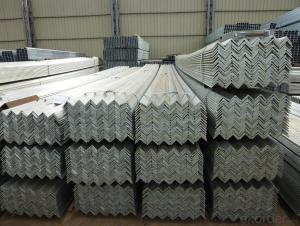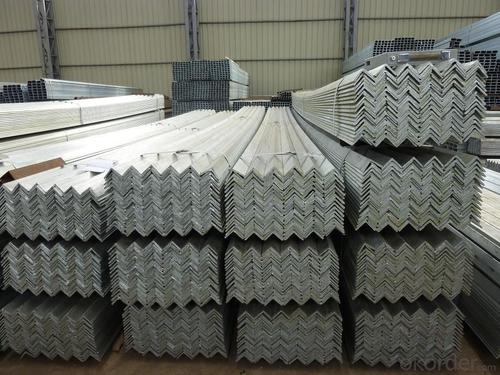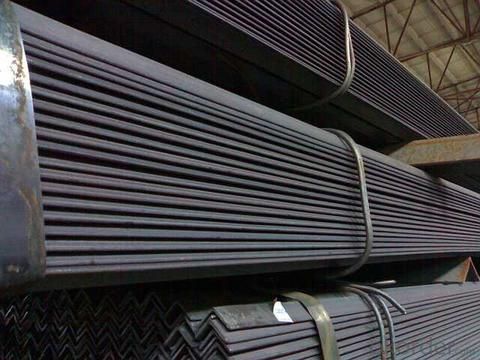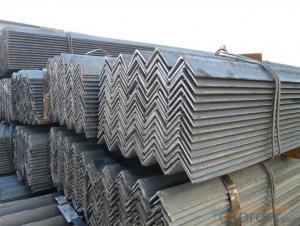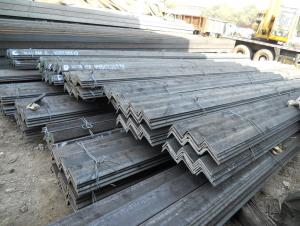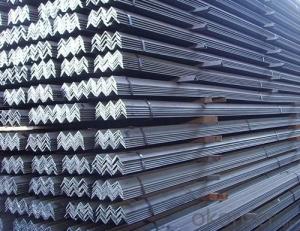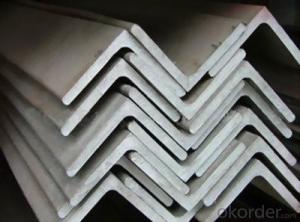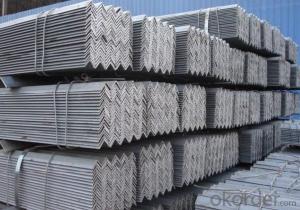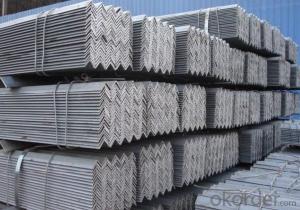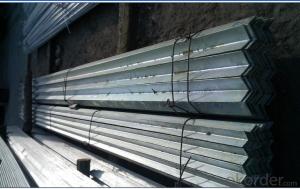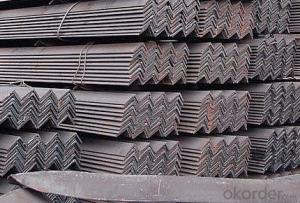Product Description:GB Standarder High Quality Angle Steel
- Loading Port:
- Tianjin
- Payment Terms:
- TT or LC
- Min Order Qty:
- 25 m.t.
- Supply Capability:
- 2000 m.t./month
OKorder Service Pledge
OKorder Financial Service
You Might Also Like
Product Description:
OKorder is offering Angle Steel great prices with worldwide shipping. Our supplier is a world-class manufacturer of steel, with our products utilized the world over. OKorder annually supplies products to European, North American and Asian markets. We provide quotations within 24 hours of receiving an inquiry and guarantee competitive prices.
Product Applications:
According to the needs of different structures, Angle can compose to different force support component, and also can be the connections between components. It is widely used in various building structures and engineering structures such as roof beams, bridges, transmission towers, hoisting machinery and transport machinery, ships, industrial furnaces, reaction tower, container frame and warehouse etc.
Product Advantages:
OKorder's Angle Steelare durable, strong, and resist corrosion.
Main Product Features:
· Premium quality
· Prompt delivery & seaworthy packing (30 days after receiving deposit)
· Corrosion resistance
· Can be recycled and reused
· Mill test certification
· Professional Service
· Competitive pricing
Product Specifications:
1. Invoicing on theoretical weight or actual weight as customer request
2. Length: 6m, 9m, 12m as following table
3. Sizes
Sizes: 25mm-250mm | ||
a*t | ||
25*2.5-4.0 | 70*6.0-9.0 | 130*9.0-15 |
30*2.5-6.6 | 75*6.0-9.0 | 140*10-14 |
36*3.0-5.0 | 80*5.0-10 | 150*10-20 |
38*2.3-6.0 | 90*7.0-10 | 160*10-16 |
40*3.0-5.0 | 100*6.0-12 | 175*12-15 |
45*4.0-6.0 | 110*8.0-10 | 180*12-18 |
50*4.0-6.0 | 120*6.0-15 | 200*14-25 |
60*4.0-8.0 | 125*8.0-14 | 250*25 |
Note:
1. According to national standard (GB) for our products, if not, supply according to national standards (GB) or agreement.
2. We can not only provide electric furnace +LF+VD and electro-slag re-melting (ESR)steel forging materials, but also forging products of piece, bar, etc.
3. Our company is equipped with roll equipment and can provide our customers with roll billets or finished.
4. Please send us your detailed specifications when inquire. We will reply to you ASAP.
FAQ:
Q1: Why buy Materials & Equipment from OKorder.com?
A1: All products offered byOKorder.com are carefully selected from China's most reliable manufacturing enterprises. Through its ISO certifications, OKorder.com adheres to the highest standards and a commitment to supply chain safety and customer satisfaction.
Q2: How do we guarantee the quality of our products?
A2: We have established an advanced quality management system which conducts strict quality tests at every step, from raw materials to the final product. At the same time, we provide extensive follow-up service assurances as required.
Q3: How soon can we receive the product after purchase?
A3: Within three days of placing an order, we will begin production. The specific shipping date is dependent upon international and government factors, but is typically 7 to 10 workdays.
Images:
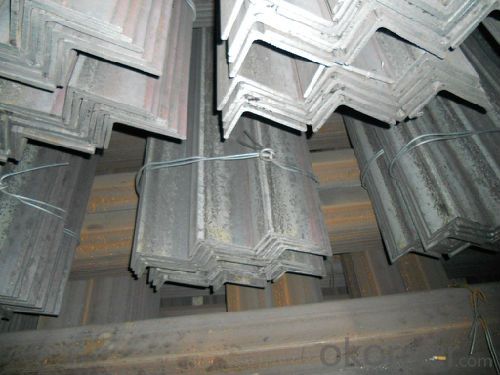
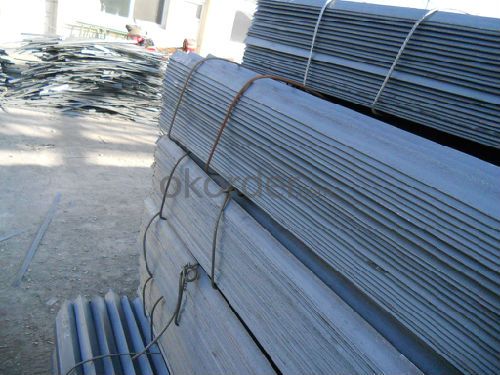
- Q: What are the different corrosion protection methods for steel angles?
- There are several different corrosion protection methods available for steel angles, depending on the specific application and environmental conditions. Some of the most common methods include: 1. Galvanization: This involves coating the steel angles with a layer of zinc, which provides excellent corrosion resistance. The zinc layer acts as a sacrificial anode, corroding instead of the underlying steel. 2. Paint coatings: Applying a high-quality paint coating to the steel angles can provide effective corrosion protection. The paint acts as a barrier, preventing moisture and corrosive substances from reaching the steel surface. 3. Powder coating: Similar to paint coatings, powder coating involves applying a dry powder to the steel angles and then baking it to create a durable and corrosion-resistant finish. 4. Epoxy coatings: Epoxy coatings are commonly used for steel angles that will be exposed to harsh environments or aggressive chemicals. These coatings provide excellent adhesion and resistance to corrosion. 5. Cathodic protection: This method involves using a sacrificial anode or impressed current to protect the steel angles from corrosion. The anode corrodes instead of the steel, providing long-term protection. 6. Barrier coatings: Barrier coatings, such as polyethylene or PVC wraps, provide a physical barrier between the steel angles and the surrounding environment, preventing moisture and corrosive substances from reaching the surface. 7. Hot-dip galvanizing: In this method, the steel angles are immersed in a bath of molten zinc, creating a thick layer of zinc coating that offers excellent corrosion protection. It is important to consider the specific requirements of the application when choosing a corrosion protection method for steel angles. Factors such as the environment, expected service life, and budget should be taken into account to ensure the most suitable protection method is selected.
- Q: How do steel angles compare to other structural materials?
- Steel angles are highly versatile and widely used in construction due to their strength, durability, and cost-effectiveness. Compared to other structural materials like wood or concrete, steel angles offer superior strength-to-weight ratio, allowing for lighter structural components without compromising structural integrity. Additionally, steel angles are resistant to fire, pests, and moisture, making them ideal for long-lasting and low-maintenance structures. Overall, steel angles are a reliable and efficient choice for various structural applications.
- Q: What is the difference between equal and unequal steel angles?
- Equal and unequal steel angles are structural steel components that are commonly used in construction and industrial applications. The main difference between these two types of angles lies in their dimensions and properties. Equal steel angles, also known as L-shaped angles, have equal sides and equal angles between them. They are typically used to provide support and stability in various structures, such as buildings, bridges, and machinery. The equal sides of these angles allow for symmetrical distribution of load and provide balanced strength in all directions. This makes them ideal for applications where equal support is required on both sides. On the other hand, unequal steel angles have different side lengths and different angles between them. These angles are used when there is a need for uneven load distribution or when a specific angle is required for a particular application. The longer side of the angle is typically used for load-bearing purposes, while the shorter side may be used for additional support or as a connection point. Unequal angles are commonly used in the construction of frames, brackets, and supports where unequal load distribution is expected. In terms of properties, both equal and unequal steel angles are made from carbon steel, which provides good strength and durability. These angles are typically hot-rolled or cold-formed, depending on the manufacturing process. Hot-rolled angles are produced at high temperatures, resulting in a rough surface finish but improved mechanical properties. Cold-formed angles, on the other hand, are made by bending and shaping the steel at room temperature, resulting in a smoother surface finish but slightly lower mechanical properties. In summary, the main difference between equal and unequal steel angles lies in their dimensions and load distribution capabilities. Equal angles have equal sides and are used for symmetrical load distribution, while unequal angles have different side lengths and are used for uneven load distribution or specific angle requirements. Both types of angles are made from carbon steel and are commonly used in construction and industrial applications.
- Q: How do you calculate the second moment of area for a steel angle?
- The second moment of area for a steel angle can be calculated by multiplying the width of the angle squared, multiplied by the thickness cubed, and divided by 12.
- Q: What are the different types of corrosion protection coatings for steel angles?
- There are several types of corrosion protection coatings available for steel angles, each designed to provide varying levels of protection against corrosion. 1. Paint Coatings: One of the most common types of corrosion protection coatings for steel angles is paint. Paint coatings act as a barrier between the steel surface and the corrosive elements in the environment. They are usually applied in multiple layers and can be customized to meet specific requirements, such as resistance to chemicals or UV radiation. 2. Galvanizing: Galvanizing is another widely used corrosion protection method for steel angles. It involves applying a layer of zinc to the steel surface through a process called hot-dip galvanizing. This coating provides excellent protection against corrosion as the zinc layer acts as a sacrificial anode, corroding before the steel does. Galvanized steel angles are commonly used in outdoor applications where they may be exposed to moisture and harsh weather conditions. 3. Powder Coatings: Powder coatings are a type of protective coating that is applied as a dry powder and then cured using heat. They provide a durable and corrosion-resistant finish to steel angles. Powder coatings can be customized in terms of color, texture, and thickness, offering both aesthetic appeal and enhanced protection against corrosion. 4. Epoxy Coatings: Epoxy coatings are often used for industrial applications where steel angles may be exposed to harsh chemicals or abrasive environments. These coatings form a strong, protective layer that resists corrosion, as well as chemicals, solvents, and abrasion. Epoxy coatings can be applied as a single layer or in combination with other coatings for added protection. 5. Organic Coatings: Organic coatings, such as polyurethane or acrylic coatings, are commonly used in architectural applications where steel angles require protection from corrosion while maintaining an aesthetically pleasing appearance. These coatings provide good resistance to weathering, UV radiation, and corrosion, ensuring the longevity of the steel angles. It is important to consider the specific application, environmental conditions, and budget constraints when selecting a corrosion protection coating for steel angles. Consulting with a corrosion specialist or coating supplier can help determine the most suitable coating for the intended use.
- Q: What are the different design considerations for steel angles in architectural applications?
- When it comes to using steel angles in architectural applications, there are several design considerations that need to be taken into account. These considerations include the load-bearing capacity of the angles, their structural integrity, aesthetics, and overall design flexibility. One of the primary design considerations for steel angles in architectural applications is their load-bearing capacity. Steel angles are often used to provide structural support in buildings, so it is crucial to ensure that they can withstand the anticipated loads. This involves calculating the maximum load that the angles will need to bear and selecting angles with the appropriate size and thickness to handle these loads safely. Another important consideration is the structural integrity of the steel angles. Architects and engineers need to consider factors such as the angle's resistance to bending, buckling, and shear. The design should take into account the angle's ability to distribute the loads evenly, minimizing the risk of failure or deformation. Aesthetics also play a significant role in architectural design, and steel angles can contribute to the overall visual appeal of a building. Architects may choose to incorporate angles with different profiles, finishes, or decorative elements to enhance the design and create a visually appealing structure. The angles should complement the overall architectural style and blend seamlessly with other building materials. Design flexibility is another crucial consideration when using steel angles. Architects often require angles that can be easily customized or fabricated to meet their specific design requirements. Steel angles can be cut, welded, or bent to create unique shapes and angles, allowing for creative architectural solutions. Lastly, it's important to consider the material properties and corrosion resistance of the steel angles. Architects need to evaluate the environmental conditions of the project site and select angles that can withstand exposure to moisture, chemicals, or other corrosive agents. Proper coatings or treatments can be applied to protect the angles from corrosion and ensure their longevity. In conclusion, the design considerations for steel angles in architectural applications encompass load-bearing capacity, structural integrity, aesthetics, design flexibility, and corrosion resistance. By carefully considering these factors, architects can select steel angles that meet both the functional and visual requirements of their projects, resulting in safe, durable, and visually appealing architectural structures.
- Q: Can steel angles be used in conveyor systems or material handling equipment?
- Yes, steel angles can be used in conveyor systems or material handling equipment. They provide structural support and stability, making them suitable for constructing frames and supports in conveyor systems and material handling equipment.
- Q: What are the different methods of connecting steel angles to other structural elements?
- There are several methods of connecting steel angles to other structural elements, depending on the specific application and load requirements. One common method is through welding. Welding involves melting and fusing the steel angle to the other structural element using intense heat. This creates a strong and durable connection that can withstand high loads. Welding is often used when the connection needs to be permanent and when the load requirements are significant. Another method is through bolting. Bolting involves using bolts and nuts to secure the steel angle to the other structural element. This method allows for easy disassembly and reassembly if needed, making it more flexible than welding. Bolting is often used when the connection needs to be adjustable or when the load requirements are relatively lower. Riveting is another method that can be used to connect steel angles to other structural elements. Riveting involves joining the steel angle and the other element by inserting a metal pin, called a rivet, through aligned holes and then deforming the end of the rivet to secure it in place. This method creates a strong and reliable connection, but it may be more time-consuming and labor-intensive compared to welding or bolting. Additionally, adhesive bonding can also be used to connect steel angles to other structural elements. This method involves using specialized adhesives that can bond the surfaces of the steel angle and the other element together. Adhesive bonding can provide a strong and uniform connection, and it is often used when aesthetics are important or when joining dissimilar materials. In summary, the different methods of connecting steel angles to other structural elements include welding, bolting, riveting, and adhesive bonding. The choice of method depends on factors such as the load requirements, desired flexibility, ease of assembly and disassembly, and the specific application.
- Q: Can steel angles be used for conveyor systems?
- Yes, steel angles can be used for conveyor systems. Steel angles are commonly used in construction and industrial applications due to their strength, durability, and versatility. In conveyor systems, steel angles are often used to provide structural support and stability to the conveyor framework. They can be used to connect various components of the conveyor system, such as the conveyor belt, rollers, and motor, ensuring proper alignment and smooth operation. Additionally, steel angles can be easily fabricated and customized to meet specific design requirements, making them a suitable choice for conveyor systems of different sizes and configurations.
- Q: Can steel angles be customized to specific dimensions?
- Absolutely, specific dimensions can indeed be applied to steel angles. In the realm of construction and manufacturing, steel angles hold a prevalent position and can effortlessly be tailored to meet the exact specifications of a particular project. This customization encompasses the ability to modify the length, width, and thickness of the steel angle in order to perfectly align with the desired dimensions. Through collaboration with a steel fabrication company or a metal supplier, clients can convey their precise measurements and requirements, enabling the creation of custom-made steel angles that precisely cater to the project's needs. This process ensures an impeccable fit and optimal performance, guaranteeing utmost satisfaction.
Send your message to us
Product Description:GB Standarder High Quality Angle Steel
- Loading Port:
- Tianjin
- Payment Terms:
- TT or LC
- Min Order Qty:
- 25 m.t.
- Supply Capability:
- 2000 m.t./month
OKorder Service Pledge
OKorder Financial Service
Similar products
Hot products
Hot Searches
Related keywords
